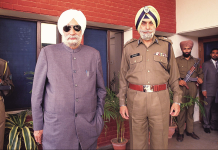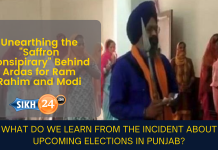Authenticity of Dasam Granth Sahib
Translated from ਦਸਮ ਗ੍ਰੰਥ ਦੀ ਪਰਮਾਣਿਕਤਾ
Original Author: Bhai Piara Singh Padam
Guru Gobind Singh Ji, the tenth heir of Guru Nanak Dev Ji, possessed great qualities of a warrior and a poet. He used the might of sword and pen equally to bring a revolution in the lives of common people. Without a match, he was the ideal Guru, poet and warrior. The ‘Khande-Dhaar’ Bani of Guru Gobind Singh Ji is so powerful that it possesses powers to turn water into Amrit and make volcanoes erupt from lifeless soil to give birth to revolutions. This is not merely an example of a fantasy; the life story of Guru Gobind Singh Ji is full of such examples.
An example of Guru Gobind Singh Ji’s warrior spirit comes from the creation of the Khalsa Panth and the bani in ‘Dasam Granth Sahib’ details his influential ability as a high-class poet very precisely. The Dasam Granth Sahib is a collection of various writings of the Dasam Guru which was compiled after his ‘jyoti-jot’ with the motivation and instructions of Mata Sundar Kaur Ji. This effort was undertaken by Bhai Mani Singh Ji’s attendant scholars, including Bhai Sheea Singh Ji. The following are the prominent writings of the Dasam Granth Sahib:
Bachitar Natak and Charitro Pakhyaan are the two most extensive banis of Dasam Granth Sahib. The Bachitar Natak narrates the tail of various ancient gods and goddesses in a modern and enthusiastic way. Terminology and wording full of bir-russ is used to help people learn appropriate lessons from the lives of their idols. The banis focus chiefly on the common people so they could be influenced to take part in the revolution started by Guru Sahib. Maintaining traditions isn’t very difficult, but to use these traditions to scheme for contemporary development is certainly an art. This was the main purpose of mentioning stories and tales of various dieties. Guru Gobind Singh Ji made sure that he isn’t mistaken as a worshipper of demigods and he clearly denounced such worship in many places in Dasam Granth Sahib. He states that his main notion behind writing accounts of Sri Ram, Sri Krishna and Durga is only to lift the spirit of war in the people:
ਅਵਰਿ ਬਾਸਨਾ ਨਾਂਹਿ ਪ੍ਰਭ, ਧਰਮਜੁੱਧ ਕੇ ਚਾਇ॥2491॥ (ਕ੍ਰਿਸ਼ਨਅਵਤਾਰ)
I have composed the discourse of the tenth part (Skandh) of Bhagavat in the vernacular; O Lord! I have no other desire and have only the zeal for the war fought on the basis of righteousness.2491.
Another clear note from the Krishna Avtar:
ਕਾਨਿ ਸੁਨੇ ਪਹਿਚਾਨ ਨ ਤਿਨ ਸੋ। ਲਿਵ ਲਾਗੀ ਮੋਰੀ ਪਗ ਇਨ ਸੋ॥434॥ (ਕ੍ਰਿਸ਼ਨਅਵਤਾਰ)
I do not adore Ganesha as being the highest and also do not meditate on Krishna and Vishnu; I have only heard about them with my ears and I do not recognize them; my consciousness is absorbed at the feet of the Supreme Kal (the Immanent Akal Purakh).434.
A similar note is found in the katha of Rama Avtar:
ਤਬ ਤੇ ਕੋਊ ਆਂਖ ਤਰੇ ਨਹੀਂ ਆਨਯੋ।
ਰਾਮ ਰਹੀਮ ਪੁਰਾਨ ਕੁਰਾਨ
ਅਨੇਕ ਕਹੈਂ ਮਤ ਏਕ ਨ ਮਾਨਯੋ॥863॥
O God ! the day when I caught hold of your feet, I do not bring anyone else under my sight; none other is liked by me now; the Puranas and the Quran try to know Thee by the names of Ram and Rahim and talk about you through several stories, but I do not accept any of their opinions.
The four hundred and five chapters long Charitro Pakhyaan states prevalent tails of misconduct by men and women. These were penned for the purpose of ensuring that the newly initiated ‘Sant Sipahis’ (Saintly Warriors) do not become victim to such wrongdoing. In those days, brothels were rather popular and existed freely without interference of law or common norms. The soul purpose of writing such stories was to keep the Sikhs on the right path. For Example:
ਬਿਛੂ ਬਿਸੀਅਰ ਬੇਸਵਾ, ਕਹਹੁ ਕਵਨ ਕੇ ਮੀਤ। (ਚਰਿਤ੍ਰ 16)
(She) is not acquainted with love; her attachment remains limited to money. Has a scorpion, snake or a prostitute ever been friends with anyone?
The same teaching is again repeated in the following stanzas:
ਪੂਤ! ਯਹੈ ਪ੍ਰਣ ਤੋਹਿ, ਪ੍ਰਾਣ ਜਬ ਲਗ ਘਟਿ ਥਾਰੇ,
ਨਿਜ ਨਾਰੀ ਕੇ ਸੰਗ ਨੇਹੁ ਤੁਮ ਨੀਤ ਬਢਈਅਹੁ
ਪਰ ਨਾਰੀ ਕੀ ਸੇਜ ਭੂਲਿ ਸੁਪਨੇ ਹੂੰ ਨ ਜਈਅਹੂ॥51॥
Ever since growing up, my Guru gave me the following instructions: “Son! As long as there is breath in your body, continually increase the affection with your wife and do not go into the bed of another woman even in dreams.”
ਪਰ ਨਾਰੀ ਕੇ ਭਜੇ ਚੰਦ੍ਰ ਕਾਲੰਕ ਲਗਾਏ
ਪਰ ਨਾਰੀ ਕੇ ਹੇਤੁ, ਸੀਸ ‘ਦਸ ਸੀਸ ਗਵਾਯੋ
ਹੋ ਪਰ ਨਾਰੀ ਕੈਹਤੁ, ਕਟਕ ਕਵਰਨ ਕੋ ਘਾਯੋ॥42॥ (ਚਰਿਤ੍ਰ 21)
Because Indra mated with another’s woman, he came to bear thousands of marks of female organs. The same reason caused denigration to the moon. Forsake of another’s women, Ravan also had to loose his ten heads and the same also caused devastation to the Kauravs.
ਮੂਤ੍ਰ ਧਾਮ ਕੋ ਪਾਇ, ਕਹਹਿ ਹਮ ਭੋਮ ਕਮਾਵਹਿ
ਥੂਕ ਤ੍ਰਿਯਾ ਕੋ ਚਾਟਿ, ਕਹਿਤ ਅਧਰਾਮ੍ਰਿਤ ਪਾਯੋ
ਬ੍ਰਿਥਾ ਜਗਤ ਮੈਂ ਜਨਮ, ਬਿਨਾ ਜਸਦੀਸ਼ ਗਵਾਯੋ। (ਚਰਿਤ੍ਰ 81)
One faces many pains while in the womb of his mother. By mating with a woman and licking her saliva, he claims to receive pleasures. But at the end his life is wasted in the world without meditation of God.
These teachings are asserted by almost all lecturers during Anand Karaj and never does anyone in the Sikh Sangat demonstrate any rejection of them. It is true that some graphical words exist in these stories but they have only been used to save the Sikhs from such misconduct. Most Sikhs do not perform Akhand Path of these stories and neither are they read during the daily nitnem. The Bani ‘Kabio Bach Benti Chaupae’ which appears at the end of this Granth is however read by Sikhs for Amrit Sanchars and also during the daily nitnem. No one has ever raised questions about its authenticity.
These are not merely ‘stories or tales’; these are banis which entail Gurmat principles but don’t need to be dissertated. There have been many who have also raised doubts on other parts of this Granth. Some state that the Dasam Granth Sahib was penned by the Darbari poets but reality is totally opposite to this. By becoming victims of such doubts, people became unsuccessful in understanding the main purpose of Guru Sahib and the ‘self-acclaimed’ scholars kept on uttering nonsense. Those who had not even read Dasam Granth Sahib started presenting baseless arguments against it. To realize the authenticity of Dasam Granth Sahib, all readers must bring their attention to the following straight-forward points:
- The Hazoori Sikhs of Guru Gobind Singh Ji who were accustomed with all aspects of his life compiled the ‘Granth of the Tenth Guru’ after his physical departure from this world. The letter by Bhai Mani Singh Ji also supports this fact.
- All the copies (around a dozen) of Dasam Granth Sahib that were compiled during the eighteenth century contain all the above mentioned banis. There is no difference in their content.
- The internal content of this Granth also proves that its author is Guru Gobind Singh Ji. In his own composition, Guru Sahib states:
ਅਬ ਮੈਂ ਆਪਨੀ ਕਥਾ ਬਖਾਨੋ। ਤਪ ਸਾਧਤ ਜਿਹ ਬਿਧਿ ਮੁਹਿ ਆਨੋ। (ਬਿਚਿਤ੍ਰ ਨਾਟਕ)
Now I relate my own story of how God sent me in the world while I was absorbed in meditation.
andਸੇਵਕ ਸਿੱਖ ਹਮਾਰੇ ਤਾਰੀਅਹਿ। ਚੁਨਿ ਚੁਨਿ ਸ਼ਤ੍ਰ ਹਮਾਰੇ ਮਾਰੀਅਹਿ। (ਚੌਪਈ ਸਾਹਿਬ)
Cross over the world-ocean these devotees and Sikhs that belong to You. Pick up my foes and destroy them. - The language used in the Dasam Granth Sahib also explains that its author is none other than the Mahaakavi Guru Gobind Singh Ji. Guru Sahib used words such as Bhagauti, Kharag, Khag, Tegh, As, Asthuj, Khargait, Kirpan, Kaal, Mahakaal, Sarbkaal, Sarbloh, Mahaloh, etc. to refer to Akal Purakh. None of these words have been used by any of the Darbari poets. These and other similar ones appear throughout the writings of Guru Gobind Singh Ji.
- It was customary for the Darbari Kavis to start their writings by praising Guru Gobind Singh Ji but at no instance a manglacharan exists in Dasam Granth Sahib that praises a certain individual, rather Guru Gobind Singh Ji has addressed the might of Almighty God in all of his writings.
- There are some Chhands that appear concurrently in the Bachitar Natak and the Charitro Pakhyan. These include: “ਮੇਰੁ ਕੀਯੋ ਤਿਣ ਤੇ” and “ਯਾ ਕਾਗਦ ਦੀਪ ਸਬੈ ਕਰਕੈ” among others.
- It was prevalent amongst the previous generation of Sikhs to revere all contents of Dasam Granth Sahib as writings of Guru Gobind Singh Ji. This is the reason the following Panthik instruction was passed:
Everyday, pick and memorize the banis of the two Granths. (Rehitnama, Bhai Desa Singh)
Just like in Guru Granth Sahib Ji, names such as Madho, Kamlapat, Gopal (Vishnu), Keshav, Syaam (Krishna), Raam, Raghunaath (Ramchandar), etc. are used; Guru Gobind Singh Ji used old and prevalent names to bring all castes and creeds together. To censure something without reading, listening or understanding is very foolish. By walking on this path, many have suffered, and at the end they have had to apologize.
The simple answer to those who question the necessity of writing about Avtars is that the Avtar Katha was written solely to awaken the spirit of the Hindus. If their idols such as Raam, Krishna, Bheem and Arjun could dare to destroy dreadful demons, they too can take part in Dharam Yudhs. And as stated earlier, the only reason behind writing stories of adulterous misconduct was to raise awareness within the newly initiated Sikhs. Furthermore, one needs to realize that if authenticity of Dasam Granth Sahib was indeed questionable; its contents would have never been included in nitnem that is prescribed by the sixty year old ‘Sikh Rehit Maryada’.
Another doubt that is raised upon the authenticity of Dasam Granth Sahib includes the question of whether Guru Gobind Singh Ji really had the time to pen such a great amount of bani. According to historical facts that exist, Guru Gobind Singh Ji wrote the banis that make up this Granth between 1675 and 1700, which is a period of twenty five years. It was after this time that Guru Sahib’s attention remained focused towards wars and battles. A period of twenty five years is enough to work on a compilation as lengthy as the Dasam Granth Sahib. Guru Sahib was the Guru; even his Sikhs such as Bhai Santokh Singh, Giani Gian Singh, and Bhai Veer Singh penned thousands of pages in a period of a few years.
We also need to consider that the Avtar Katha in Dasam Granth Sahib provides priceless information on many of the ancient stories that have been included in Guru Granth Sahib Ji. Dasam Granth Sahib has long been used significantly by learned scholars and historians. The information provided in this Granth is important to understand several aspects of Guru Granth Sahib Ji’s bani. Without the guidance of this Granth, Sikhs would be misguided with the misinformation that exists about various avtars and historical epics and tails.





Waheguru!